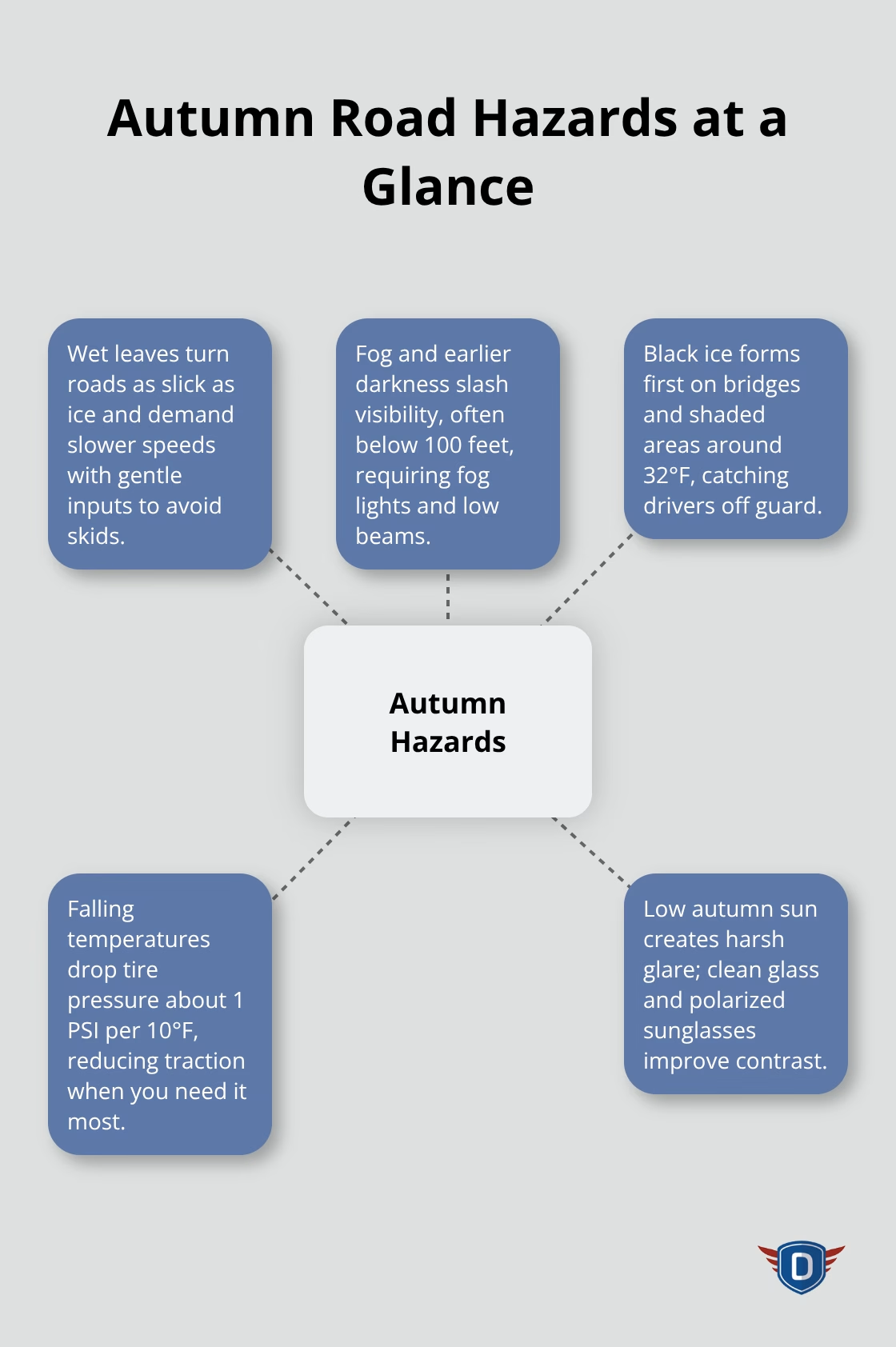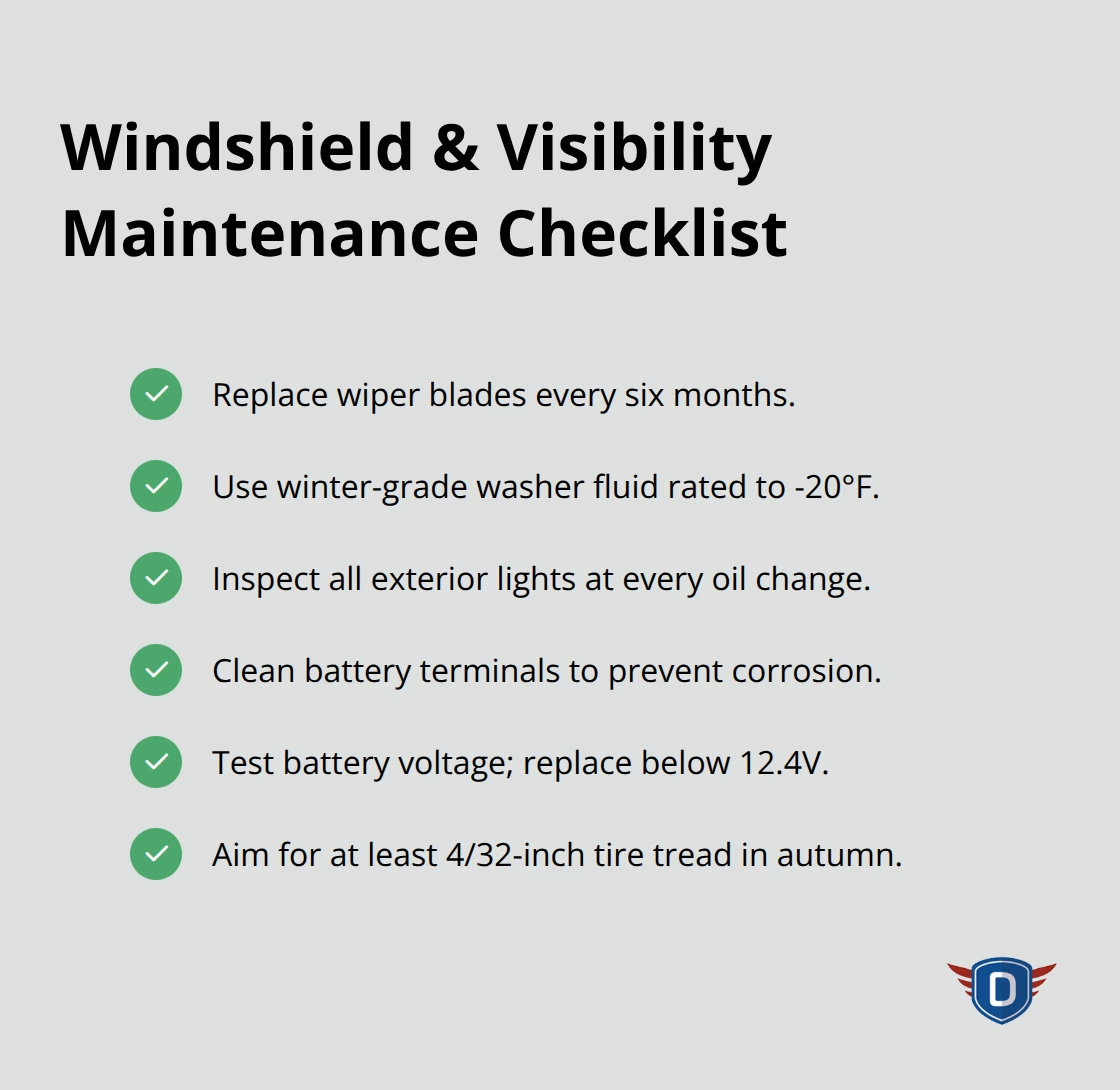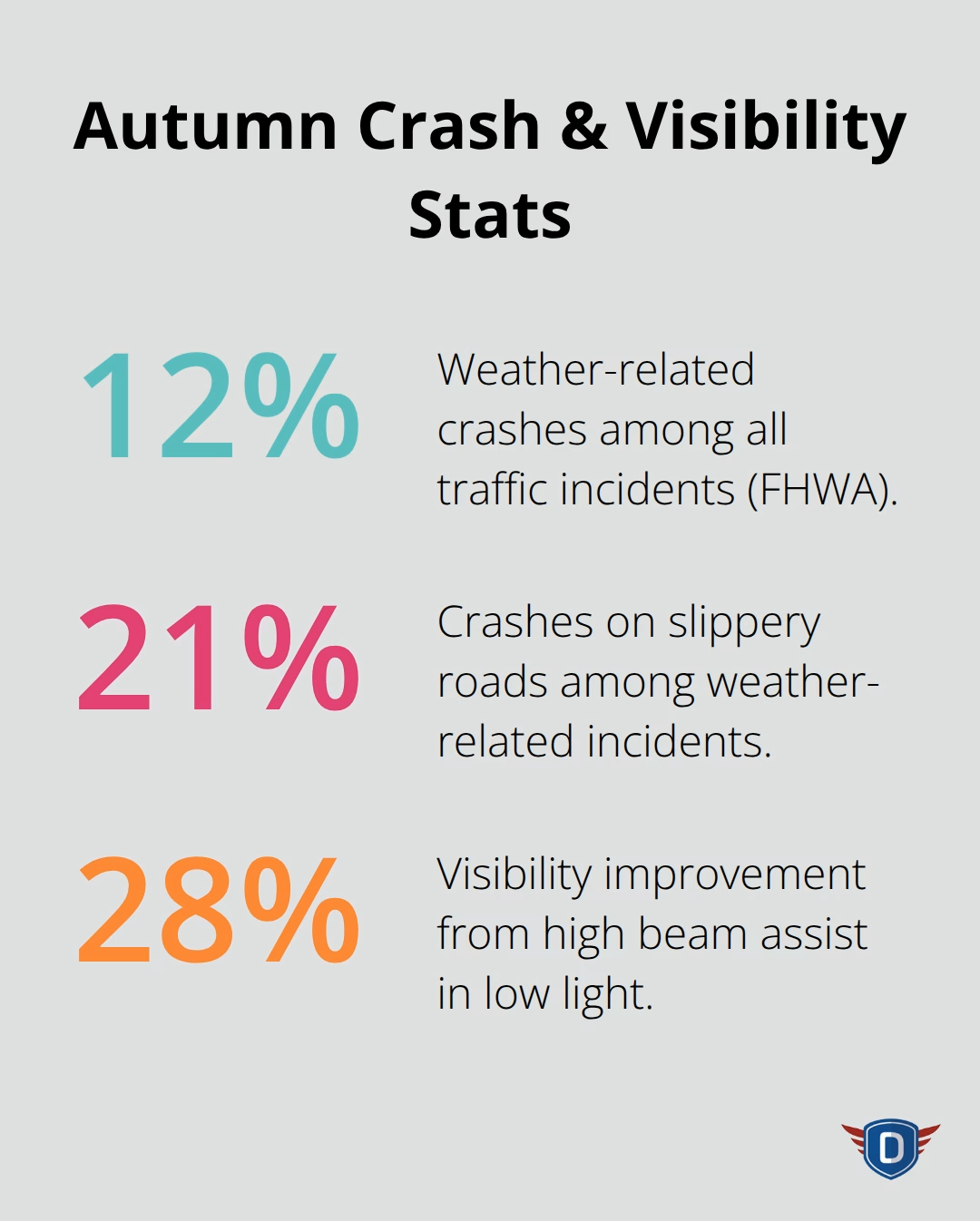Autumn brings unique driving challenges that catch many drivers off guard. Wet leaves, sudden fog, and temperature drops create hazardous road conditions across the country.
At floridadetscourse.com, we’ve compiled essential autumn driving safety tips to help you navigate these seasonal risks. Proper preparation and adjusted driving techniques can prevent accidents during this transitional season.
What Weather Hazards Make Autumn Drivers Face the Greatest Risks
Wet leaves create the most dangerous autumn road conditions, turning surfaces as slippery as ice. The waxy coating on fallen leaves blocks water absorption, which makes them extremely hazardous when moisture appears. Crashes on slippery roads account for approximately 21% of weather-related incidents. Drivers should reduce speed by 15-20% when they approach leaf-covered areas and avoid sudden stops or sharp turns on these dangerous patches.
Fog and Darkness Destroy Driver Visibility
Autumn fog cuts visibility to less than 100 feet in many regions, while daylight savings time forces drivers into darker conditions earlier each day. The Insurance Institute for Highway Safety found that high beam assist technology enhances visibility by 28% during low-light conditions. Drivers must keep fog lights functional and avoid high beams in fog (they reflect back and worsen visibility). Clean windshields prevent internal fogging, and polarized sunglasses combat the intense glare from the lower autumn sun position.

Temperature Changes Create Unexpected Ice Patches
Autumn temperature swings produce black ice on bridges and shaded road areas when drivers least expect it. Roads freeze at 32 degrees Fahrenheit, but bridges and overpasses freeze first because cold air circulates above and below these structures. Tire pressure drops one PSI for every 10-degree temperature decrease, which reduces traction when drivers need it most. Check tire pressure weekly during autumn months and maintain proper tread depth with the quarter test – if Washington’s hair shows, replace tires immediately for optimal grip on potentially icy surfaces.
These autumn hazards require specific vehicle preparations to maintain safety on the road.
What Vehicle Preparations Prevent Autumn Accidents
Proper tire maintenance becomes critical when autumn temperatures drop and road conditions deteriorate. Check tire pressure weekly during fall months because pressure decreases one PSI for every 10-degree temperature drop, according to AAA data. The National Highway Traffic Safety Administration mandates tire replacement when tread depth reaches 2/32 of an inch, but smart drivers replace tires at 4/32 for autumn safety. Use the quarter test monthly – insert a quarter into tire grooves with Washington’s head down, and if his hair remains visible, immediate replacement prevents dangerous blowouts on wet leaves or ice patches.
Battery Performance Drops in Cold Weather
Car batteries experience reduced performance when temperatures fall below freezing, and three-year-old batteries fail most frequently during autumn’s first cold snap. Test battery voltage with a multimeter – readings below 12.4 volts indicate replacement needs before winter arrives. Clean battery terminals with baking soda solution to prevent corrosion buildup that reduces electrical flow to headlights and wipers.
Windshield Systems Need Immediate Attention
Replace windshield wipers every six months without exception because worn blades streak glass and reduce visibility by up to 30% during autumn rains. Fill washer fluid reservoirs with winter-grade solution that prevents freezing down to -20 degrees Fahrenheit. Check all vehicle lights during oil changes – headlight bulbs burn out 40% more frequently in cold weather, and functional taillights prevent rear-end collisions when visibility drops.

Headlight Performance Affects Safety
Inspect headlight lenses for cloudiness that reduces light output by 50%, and replace them immediately for maximum illumination during shorter daylight hours. Cloudy lenses scatter light instead of focusing it on the road ahead (creating dangerous blind spots). Polish headlight covers with restoration kits or replace entire assemblies when damage becomes severe. Using your low-beam headlights during rain and mist significantly improves visibility for both you and other drivers.
These vehicle preparations work best when drivers adapt their safe winter driving techniques to match autumn’s challenging conditions.
How Do You Adjust Your Driving for Autumn Road Hazards
Drop your speed by 15-20% on leaf-covered surfaces and maintain a four-second following distance instead of the standard three-second rule. The Federal Highway Administration reports that weather-related crashes account for approximately 12% of all traffic incidents, which makes speed adjustment your primary defense against autumn accidents. Wet leaves create surfaces as slippery as ice patches and require gentle acceleration and braking to maintain vehicle control.

Apply brakes gradually before you reach leaf accumulations rather than while you drive over them. Avoid sudden steering movements that can trigger dangerous skids on these treacherous surfaces.
Headlight Usage Prevents Most Autumn Accidents
Turn on low-beam headlights during all daylight hours in autumn weather conditions (including light rain, mist, and overcast skies). High-beam headlights reflect off fog and rain droplets and create a dangerous wall of light that reduces visibility instead of improving it. The Insurance Institute for Highway Safety found that vehicles with good headlight ratings have 19% fewer nighttime single-vehicle crashes and 23% fewer nighttime pedestrian crashes.
Use turn signals earlier than normal during autumn months because reduced visibility requires longer warning times for other drivers. Clean headlight lenses monthly because road salt and debris reduce light output by up to 50% during autumn months.
Skid Recovery Requires Immediate Correct Actions
Steer into the direction of the skid when your vehicle loses traction on wet leaves or ice patches – if your rear end slides right, turn the steering wheel right. Avoid hitting the brakes during a skid because this action makes recovery impossible and extends the slide distance. Pump anti-lock brakes gently instead of applying steady pressure (keep both hands firmly on the steering wheel at the 9 and 3 o’clock positions for maximum control).
Practice skid recovery techniques in empty parking lots during the first autumn rainfall to build muscle memory before you encounter real emergencies on busy roads.
Final Thoughts
Autumn driving safety tips demand immediate action from every driver who wants to avoid weather-related accidents. The 21% of crashes caused by slippery road conditions prove that preparation saves lives during this dangerous season. Vehicle maintenance becomes your first line of defense – weekly tire pressure checks, functional windshield wipers, and clean headlights prevent most autumn emergencies before they happen.
Speed reduction and increased distances work together to combat wet leaves and unexpected ice patches. The four-second rule replaces normal distances when road conditions deteriorate. Turn on low-beam headlights during all autumn weather conditions and practice skid recovery techniques in safe environments.
Weather patterns change rapidly during autumn months, which means drivers must adapt their habits continuously. Temperature swings create black ice on bridges while fog reduces visibility to dangerous levels within minutes (often in less than five minutes). At floridadetscourse.com, we provide comprehensive driver education programs that teach students how to handle these seasonal conditions with confidence and skill.







